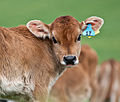Veal
![]()
The title of this article is ambiguous. For other meanings, see Veal (disambiguation).
![]()
This article or subsequent section is not sufficiently supported by evidence (e.g., anecdotal evidence). Information without sufficient evidence may be removed in the near future. Please help Wikipedia by researching the information and adding good supporting evidence.
Veal (also veal) is the meat of cattle (calves) a few weeks to months old. It is generally more tender and lighter in colour than beef. Depending on the age and the type of rearing and feeding, it has a light red, pink or whitish colour. With pasture keeping and pure green fodder the meat turns red, with stable fattening it is lighter. There are different stages of fattening: in the first stage, the calves are housed in individual stalls so that they can be observed and fed. At this stage the calves can see each other. At six weeks of age, they are kept in groups of at least three. It is the common practice that the animals have enough light so that they can develop well. Feed containing little iron can be used to produce "white" veal, as iron gives the meat a reddish colour. Milk replacers enriched with coconut and palm fat are mainly used for this purpose. Higher prices are obtained for the characteristic lighter meat.
Calves in Germany are usually slaughtered at the age of about 22 weeks. This corresponds to around 2 % of their natural maximum life expectancy of 20 years. When they are slaughtered, calves have a slaughter weight of around 150 kg. If a calf that is not yet fully grown weighs more than this, it is referred to as young cattle. Up to now, however, there has been no legal definition of this in the relevant trade categories for beef. However, in June 2007 the European Union defined for the entire EU which meat may be called veal. According to this, calves may not be older than eight months, and between eight and twelve months they are considered young cattle. The regulation came into force on 1 July 2008.
While in many European countries fattening calves are mainly fattened on milk and dairy products and slaughtered at the age of a few months, in some countries such as Denmark, Spain and the Netherlands there is a different rearing system in which the animals are mainly fed on cereals and are not slaughtered until after the tenth month. These animals for slaughter must be marketed as young cattle.

Veal (from the nut)
Production and consumption
The EU produces a total of around 800,000 tonnes of veal per year. The main producing countries are France (30% share), the Netherlands (26%), Italy (18%), Belgium (7%) and Germany (6%). The largest consumer countries are France and Italy.
In Germany, an estimated 9 kg of net (excluding tendons and bones) veal and beef was eaten per capita in 2016. In Austria, net consumption amounted to 17.4 kg/person in 2015, while gross meat consumption here was 97.2 kg/capita.
The parts of the veal that are suitable for roasting are considered to be of particularly high quality, namely those from the back and the leg (topside, underside and nut). The neck, belly, brisket and shanks are suitable for cooking and braising. The calf's head, tongue and ears are rarely used in cooking today.
Veal is low in fat and should be cooked gently so that it does not dry out.
·
Dairy calves
· 
Calf
· 
Calves slaughtered
· 
Veal shank
· 
Raw veal chop with fillet
Market Relief Measures
Because the supply of domestic calves for slaughter in Switzerland exceeds demand in spring as a result of the main calving season in winter, veal is stored in spring to support calf prices. Based on Article 50 paragraph 1 of the Agriculture Act, the Confederation pays meat processing companies around CHF 3 million per year as a contribution to storage costs and the loss in value resulting from the freezing of veal.
Questions and Answers
Q: What is veal?
A: Veal is the meat of young cattle, specifically calves, as opposed to beef from older cattle.
Q: Where does most veal come from?
A: Most veal comes from male calves of dairy cattle breeds.
Q: Can veal be made from female calves?
A: Yes, veal can be made from a calf of either sex and any breed.
Q: How does the texture of veal differ from beef?
A: Veal has a tender texture compared to beef.
Q: What is the age range of the cattle that veal comes from?
A: Veal comes from young calves, which are typically less than four months old.
Q: What is the predominant source of veal in the market?
A: The predominant source of veal in the market is from male calves of dairy cattle breeds.
Q: Why is veal often described as having a tender texture?
A: Veal is often described as having a tender texture because the meat is taken from young calves that have not been exposed to much physical activity, resulting in a more tender meat.
Search within the encyclopedia
